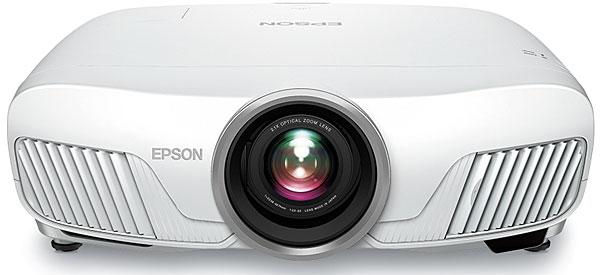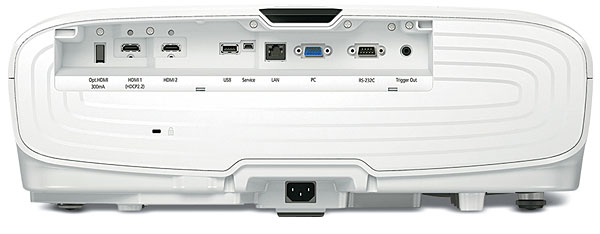Epson Home Cinema 4000 4K Enhanced 3LCD Projector Review

AT A GLANCE
Plus
Good resolution in HD and UHD
Impressive HDR
Low price
Minus
Contrast and black level could be better
Manual HDR/SDR
switching
THE VERDICT
The Epson 4000 offers an effective combination of HDR and SDR projection at a price that seemed impossible a year ago.
Native 4K imaging—where the chips display all 8.3 million individual pixels (3840 x 2160) in each frame simultaneously—is still rare in an affordable consumer projector. Currently, the entry price is $5,000, for Sony’s new VPL-VW285ES. But last year, Epson introduced two 3LCD models that use pixel shifting to achieve an apparent resolution close to 4K. The less expensive of the two was the PowerLite Home Cinema 5040UB, still selling, as I write this, for around $2,700. (Its virtual twin, the Pro Cinema 6040UB, was reviewed in the October 2016 Sound & Vision.)
Epson calls their technology “4K Enhancement.” The imaging chips (one each for red, green, and blue) each provide 2 million pixels—standard 1080p. The 8.3 million pixels that make up each frame of a consumer 4K source are first processed down to roughly 4 million. These are then split into a pair of 2 million sub-frames. After the first of these subframes is displayed, the image is shifted diagonally by a microscopic amount, and the second sub-frame is displayed. The result: 4 million pixels are visible on the screen, displaced in time but flashed in sequence so quickly that persistence of vision makes them appear to be simultaneous.
JVC, of course, uses a similar technique in most of their LCOS designs, currently starting at $4,000. But now we have the Epson Home Cinema 4000, a pixel shifter at a very attractive $2,200. It offers most of the features of the 5040UB and brings 4K signal compliance, high dynamic range, wide color gamut, and Epson’s 4K Enhancement to more potential buyers than ever before.
Features
The Home Cinema 4000 is capable of HDR10 high dynamic range (but not Dolby Vision) plus 10-bit color with a claimed 100 percent coverage of DCI-P3. Epson also claims 2,200 lumens and a 140,000:1 contrast ratio—specs to take with a grain of salt without knowing the test methods used.
The projector includes a motorized lens cover plus motorized shift, focus, and zoom, the last with a generous 2.1 range. These lens adjustments were slow to respond and tricky to set, but with patience, I found that they did the job—and it’s unusual to even get powered lens features on a projector at this price. There are 10 programmable lens memories; I used one for 1.85:1 material and a second for 2.40:1. A Blanking control lets you crop the image on the top, bottom, and/or sides. I experimented with it by cropping the IMAX-sized picture of Avatar to fit my Stewart Filmscreen StudioTek 130 screen (aspect ratio 2.35:1, gain 1.3). Heresy, I know (and the Cameron police may be on the way as I write), but I did it for science! The projector also supports 3D, including 2D-to-3D conversion (though it will do neither with 4K, which isn’t part of the UHD specifications). Active 3D glasses are an extra-cost option at $99.
Epson claims exceptional lamp life for all three of the projector’s lamp modes (see Specs). It also has virtually no fan-driven cool-down period on shutdown. But I’d be prepared to replace the lamp at far less than its claimed lifetime, to maintain optimum brightness, particularly for HDR.

There are two HDMI inputs, but only HDMI 1 is compliant with HDCP 2.2 copyright management. The rear panel also provides trigger, RS-232, LAN, and PC (VGA) connections, as well as a service port and a USB port, which offers power to optical cables for HDMI if used in place of the conventional metal (copper) variety. The projector can be linked to a home network video source either wired or wirelessly, the latter with an optional wireless LAN module. (The home network feature wasn’t tested for this review.)
You get six Color Modes, or picture presets, for 2D and two for 3D. But you can’t dial in different settings for HD/SDR and UHD/HDR in the same Color Mode. The only way to use the same Color Mode for SDR and HDR, each with separate settings, is to use two of the 10 programmable picture memories (different from the lens memories) and switch manually between them. But it’s easier to just use different Color Modes for SDR and HDR (as I did) with different settings for each, appropriate to the type of source (in my case, Cinema for SDR and Bright Cinema for HDR). Still, with either technique, you must make the switch between the HDR and SDR setups yourself; the Epson won’t automatically switch them in response to metadata in the source.
If you select the 4K Enhancement feature with sources of 1080p or less, the projector upconverts 1080p or lower resolutions using its lens shift. If you turn off 4K Enhancement, the Epson functions as an ordinary 2K projector with no lens shift. The 4K Enhancement feature is always on with a 4K source.
Seven different controls affect sharpness and detail in various ways. I settled on Sharpness alone and set the others to zero. I left the threeposition Frame Interpolation control off. (It can’t be used for 4K, 3D, or any interlaced source.) Meanwhile, there’s a Custom Color Temperature (white balance) menu with conventional 2-point gain and offset controls for red, green, and blue, as well as a full color management system, or CMS (RGBCMY).
The three Power Consumption (lamp level) options are Eco, Medium, and High. Eco was (for me) far too dim. In Eco and Medium, the cooling fan is very quiet, but High ratchets it up a notch or two. This is a bright projector, so Medium was fine on my screen for SDR. But for HDR and 3D, you definitely need all the punch you can get, so High was my choice for those sources. I didn’t find the fan noise noticeable in High with audio playing, but it might be intrusive in a much smaller room than mine with the projector located directly overhead.There’s also a dynamic iris with Off, Normal, and High Speed modes to improve black level on dark scenes. There’s no static iris—one distinct difference from the 5040UB, which offers both static and dynamic.
A Panel Alignment feature lets you adjust the convergence of the three LCD imaging chips (red, green, and blue). My sample was good, so I didn’t need to use it. The projector can also do picture-in-picture from its two HDMI inputs (but not with 3D or 4K sources). There are five gamma options, including Customized. And an Info menu reveals the operating conditions of the Epson, including the hours on the lamp and details on how the projector is handling the source (resolution, HDR or SDR, and color gamut, depth, and subsampling). I found no combination of control settings that would fill the screen with early DVDs produced in a letterboxed format. Most DVDs are “Enhanced for Widescreen,” and these “anamorphic” discs worked fine. This is not an issue with Blu-ray.
The remote control is backlit and comfortably large with usably sized and spaced buttons, some of which can be programmed for one of a limited selection of options. A number of other buttons include direct access to many of the projector’s functions, such as the CMS; that shortcut is a godsend for calibrators.
First Take
In our standard video tests (all of them in HD/SDR), the Epson was a mixed bag. It passed most of the tests without issue but failed 2:2 HD and 2:2 SD (which have tripped up more than a few displays we’ve reviewed in the past). It also clipped both below black and above white, which we’d prefer not to see but isn’t a deal-breaker.





























































